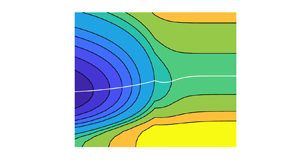Article contents
Energy stability of magnetohydrodynamic flow in channels and ducts
Published online by Cambridge University Press: 22 May 2024
Abstract

We study the energy stability of pressure-driven laminar magnetohydrodynamic flow in a rectangular duct with a transverse homogeneous magnetic field and electrically insulating walls. For sufficiently strong fields, the laminar velocity distribution has a uniform core and convex Hartmann and Shercliff boundary layers on the walls perpendicular and parallel to the magnetic field. The problem is discretized by a double expansion in Chebyshev polynomials in the cross-stream coordinates. The linear eigenvalue problem for the critical Reynolds number depends on the streamwise wavenumber, Hartmann number and the aspect ratio. We consider the limits of small and large aspect ratios in order to compare with stability models based on one-dimensional base flows. For large aspect ratios, we find good numerical agreement with results based on the quasi-two-dimensional approximation. The lift-up mechanism dominates in the limit of a zero streamwise wavenumber and provides a linear dependence between the critical Reynolds and Hartmann numbers in the duct. As the aspect ratio is reduced away from unity, the duct results converge to Orr's original energy stability result for spanwise uniform perturbations imposed on the plane Poiseuille base flow. We also examine different possible symmetries of eigenmodes as well as the purely hydrodynamic case in the duct geometry.
Information
- Type
- JFM Papers
- Information
- Copyright
- © The Author(s), 2024. Published by Cambridge University Press
Footnotes
Present address: Department of Applied Mathematics and Theoretical Physics, University of Cambridge, Centre for Mathematical Sciences, Wilberforce Road, Cambridge CB3 0WA, UK.
References
- 6
- Cited by


